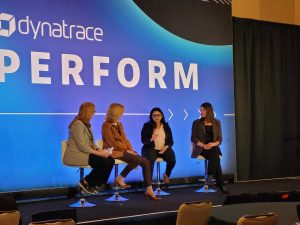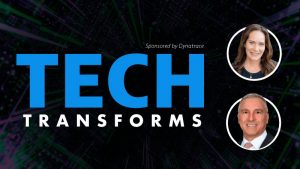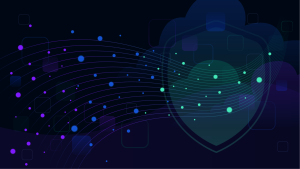The 'Women in Technology' panelists at Dynatrace Perform 2024 discussed embracing change and continuous learning--key strategies for the future of work in the AI era.
Today’s macroeconomic environment is dynamic and uncertain, generating many questions about the future of work.
New technologies are disrupting the landscape, while company mergers, acquisitions, and economic volatility abound. As artificial intelligence becomes more pervasive in organizations, the workforce senses that the future of work is undergoing massive shifts.
Proactive workforce members are acclimating to these fluid conditions through a variety of strategies, such as career “zigzagging” (a less linear career path that involves diverse roles), career upskilling, and mentoring.
For women in technology, these strategies have never been more important to help them survive and thrive as they embark on a new era of AI-enabled work, agreed panelists at the “Women in Tech” panel at Dynatrace Perform 2024.
According to Laura Heisman, Dynatrace chief marketing officer and panelist, women should embrace sudden career shifts as opportunities.
Heisman joined Dynatrace in January 2024, with an enduring career to date in the technology sector. She has held positions at Citrix Systems, GitHub, and most recently, VMware. At the outset of her career, she worked in consumer products in Southern California. Then, after being introduced to the “World Wide Web” and new types of businesses and marketing opportunities, she shifted her career course to focus on technology.

“That was a huge zig and zag for me,” Heisman recalled. She compared that moment in her career with the present picture for the workforce, as artificial intelligence matures and has a massive impact on the future of work.
“We are in a similar moment with AI,” Heisman emphasized. “Take the opportunity to learn everything you can. It is this huge moment for all of us in our careers and in how we do our jobs,” she said.
The future of work with generative AI
Data suggests that this inflection point in the future of work—spurred by generative AI (a type of artificial intelligence technology that can produce various types of content, including text, images, audio, and more)—is encouraging excitement and apprehension about job prospects in the era of AI.
According to the report, “Work, workforce, workers: Reinvented in the age of generative AI,” 95% of workers see value in working with generative AI. But approximately 60% are concerned about job loss, stress, and other issues, given the impact of AI on the workforce.
Data also suggests that the workforce is receptive to the coming tsunami of changes AI will bring, particularly in the form of upskilling and reskilling. According to a recent survey, for example, 68% of workers are aware of coming disruptions in their industries and are willing to reskill to remain competitively employed.
That’s why Heisman and other members of the “Women in Tech” panel stressed the importance of continued learning to nurture one’s career. This strategy is becoming essential to thrive in the future of work.
According to Jolly Mishra, director of partner development at Microsoft, it’s also critical for women to encourage the next generation to pursue STEM disciplines (science, technology, engineering, and math)—and to recognize that these disciplines are “cool” for women to engage with—even if younger women are not easily accepted in school as “nerds.”
Inspiring inclusion—and bucking exclusion
Sue Quackenbush, Dynatrace chief people office and panel moderator, asked the panelists about methods to inspire inclusion for women in technology. It sparked a conversation about embracing diverse work styles as key to the future of work.
Indeed, while technology companies often recognize the most assertive people in the room, those with quieter styles may have important contributions to make and that true inclusion is about bringing all good ideas to the table.
“You have to give everyone a voice,” Terese Pate, director of product development at GXC Technology, said. “Sometimes the quietest voice has the best ideas.”
At the same time, panelists noted that inclusion may not always be offered readily, and women still have to steer their own path to be recognized for their talents, not their gender, in the technology sector.
Microsoft’s Mishra recalled trying to pursue opportunities in the sector, then being told, “Don’t waste your time. They don’t accept women in technology.”
Rather than accepting a closed door to opportunity, Mishra said, the lack of inclusion became motivation for her. She was even more determined to pursue the role. “It was essentially a kind of superpower for me,” she said.
Pate agreed. “It was about learning my craft to be as good or better than anyone else in the room. They had to listen to me because I was the one who had the answers.”
Intentional—and unintentional—mentoring
Quackenbush also asked panelists about their mentors during their careers and whether mentorship was a formal process.
Pate noted that she used her entrée into technology as an opportunity to learn from her peers.
Early on, Pate sought out her mentors to teach her and help her elevate her skillset. “I said, ‘Elevate me, work with me. That is huge—and that’s how I learned,” Pate recalled.
Heisman noted that her mentoring process was more informal, with two male mentors who organically served as soundboards and guidance during her career.
“It was not sponsorship, it was mentorship, and it’s a two-way conversation, where we are building a relationship and understanding each other together,” Heisman said. This nontraditional way of thinking about mentorship breaks the barriers of hierarchy and brings parity and equal exchange to the process.
Building a career with grit
Panelists also recognized that pursuing a career in technology requires determination and grit. In some cases, women may need to believe in themselves to pursue worthy opportunities.
Heisman noted that research shows that men will apply to a job with about 60% of the qualifications, while women believe they need 100% of the skills required. That may discourage them from even applying when in fact they are qualified. Knowing this, job descriptions and hiring methods need to adjust to build diverse teams.
“Be comfortable being a woman in tech. Wear it as a badge of honor. Don’t doubt yourself and your skills,” Heisman encouraged.
But just as the future of work requires persistence, it also brings new opportunities for women in technology that may not have been as rich prior to the emergence of the COVID-19 pandemic.
As Microsoft’s Mishra noted, the normalization of hybrid work has provided all workers opportunities to participate in the sector without following traditional schedules in the office. This flexibility particularly helps women navigating caregiving responsibilities stay in the workforce.
The future of work is about diversity and inclusion
Mishra noted that as the AI era unfolds, diversity and inclusion are approaches that reflect the cornerstone of reliable, unbiased AI. Responsible, reliable AI requires a diversity of data and perspectives to enable information accuracy, freshness, and unbiased outcomes.
Mishra emphasized, “Diversity and inclusion are so important for innovation.”
For all Perform coverage, check out the Dynatrace Perform 2024 guide.
For more on digital transformation and AI, check out our report “The state of AI 2024.”





Looking for answers?
Start a new discussion or ask for help in our Q&A forum.
Go to forum